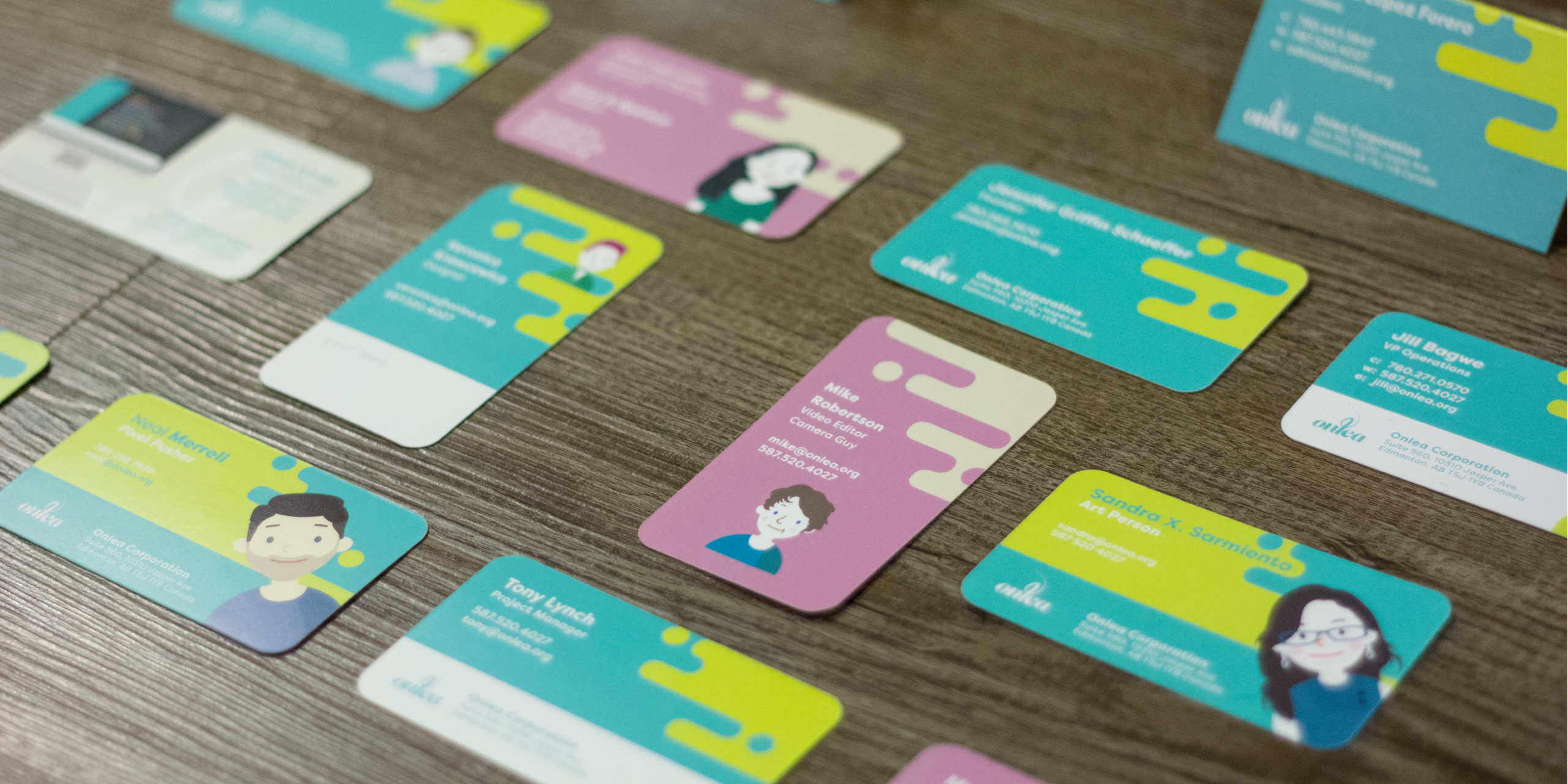Business Cards as Unique as our Team Members
A blog post by Veronica Krawcewicz, Senior Production Designer.
At Onlea we are proud of our diverse team. We wanted to reflect the uniqueness of our employees, similarly to how we create unique projects. When we create courses, videos, interactive learning objects, and apps, each project has its own visual style that is determined by the subject matter, content, clients, and target audience.
A number of months ago, we redesigned our business cards. The goal was to create business cards that each employee is proud to hand-out. The cards needed to be unique for most employees, while still reinforcing Onlea’s visual identity.

How did we approach this design challenge?
The steps were as follows:
1. Defined the problem, goals, and constraints
2. Brainstormed concepts
3. Created Mock-ups
4. Gathered feedback
5. Created a style guide and revised mock-ups
6. Had each team member either:
- Create their own business cards using the style guide
- Work with another team member to have a business card created using the style guide
7. Reviewed each others business cards
8. Had one team member (myself) make adjustments and prepare the files for print
9. Acquired approval from management
10. Sent files to print
This type of collaborative approach was possible because:
- Most of our team had some design background
- A clear style guide was created and enforced
- One designer (myself) was the main point person for the entire endeavor

What are the design constraints when creating business cards?
Business cards are limited in the amount of space available. This means that business cards should not contain too much information, and text needs to be smaller. If you use a typeface with a higher x-height, you can get away with a smaller point size while maintaining legibility. If you use an online printer to manufacture your business cards they might have a recommended minimum point size. Remember to also check the rest of the printer’s specifications (resolution, file type, colour space, size of bleed so that your business cards turn out looking the way you expected them to.
It’s typically a good idea to test print anything you are designing on a computer that is intended to be printed. Colours, and colour contrast looks different on a light emitting screen than on a light absorbing piece of paper.

There are some business card formats that allow for more surface area, including folding business cards. When designing business cards consider how you expect a user to hold and flip the card, as well as any other way you want someone to interact with the card. On a number of our business cards we left dedicated space for a handwritten note (either from us or by the recipient).

Business cards should also be consistent with the company’s visual identity. This means they should include the logo and use the colours and typeface associated with the company’s visual guidelines. We used a style guide to ensure that each business card was aligned with Onlea’s identity - even if each card was intended to be unique. This helps ensure that the different card designs are harmonious with each other, and do not degrade the company’s image.

What elements should be present in a Style Guide?
The answer to this depends on the project. In this case the style guide included: colour scheme, typeface, necessary elements, things to consider, and example mock-ups. Colour schemes and typefaces are always specified in a style guide, as these elements need to stay consistent. Usually when we create style guides for courses they are longer documents that are broken up into multiple sections which explain and show examples of the different types of video content that will be used (video, animations, titles, transitions, images/illustrations, etc.).
The example mock-ups in the style guide were subjected to critique before the style guide was created. Gathering feedback is important to determine if your design speaks to your client. It is possible to engage in an extensive research phase before starting mock-ups, but nothing will tell you better how your client will react to your design than how they actually react.
How did we gather feedback on business card designs?
Since we are a small team, this was not a complicated process. I printed out test prints of early concepts, laid them out on a table, explained that I wanted feedback, and had team members write on their thoughts on the mock-ups. If the team was even smaller a critique could have been held. In a larger team in a more spread out, or multi-location, office space an online poll would have been more appropriate. Another option with a larger team is build a representative focus group of individuals who can review the concepts instead of involving the whole company.

Two reviews were held. The first was of initial concepts. The second was of the first batch of individual business cards. Each review lead to valuable changes.
While we did not gather feedback on our business cards from their target audience(s) before sending them off to the printer, the feedback we have received since has been favourable. Remember, the larger the company, the more business cards will need to be reprinted in the event of a redesign. In those situations it may be a good idea to test reception from the target audience of the business cards before reprinting all company business cards.
If you would like to learn more about designing business cards, visual identity packages, and critiquing design work, our course on Graphic Design Fundamentals has more information on these and other topics.